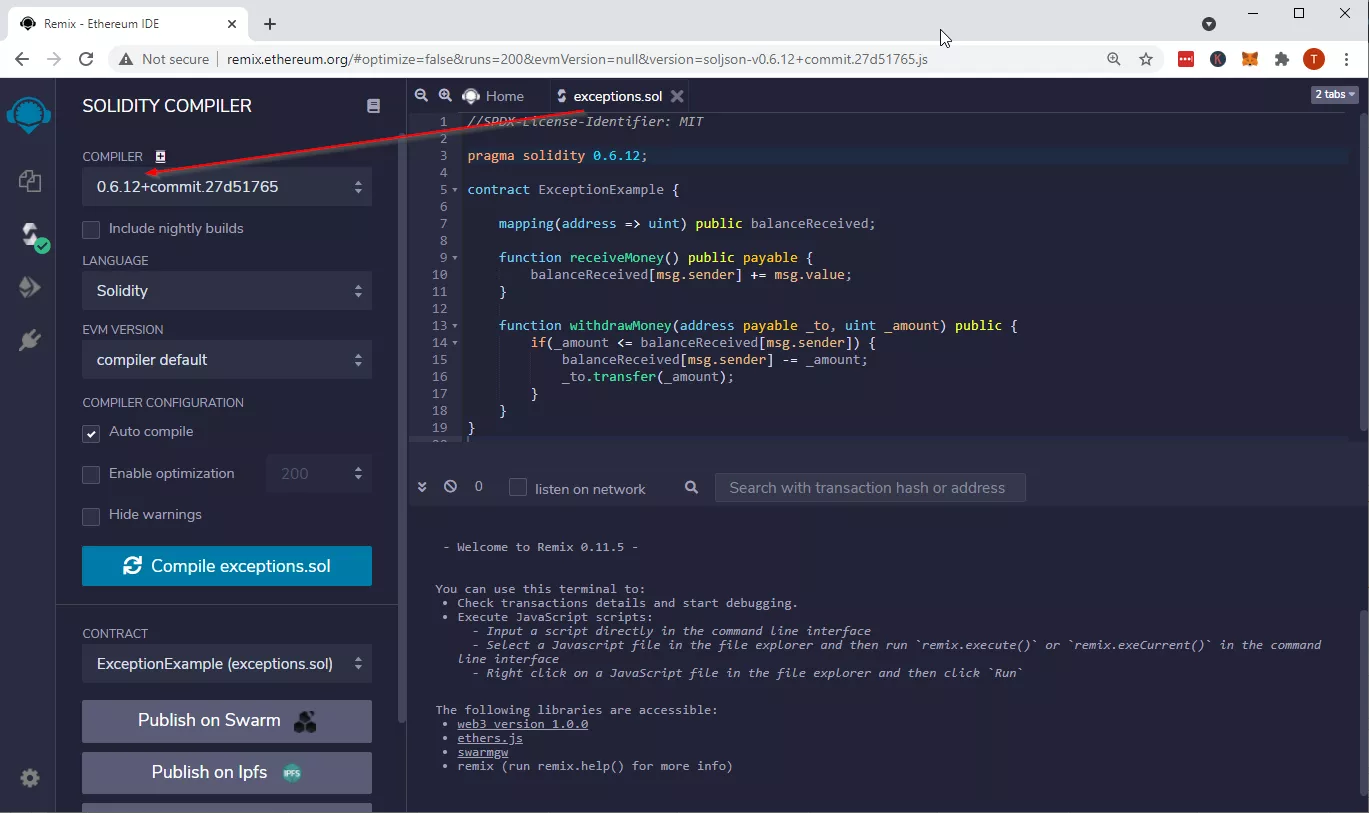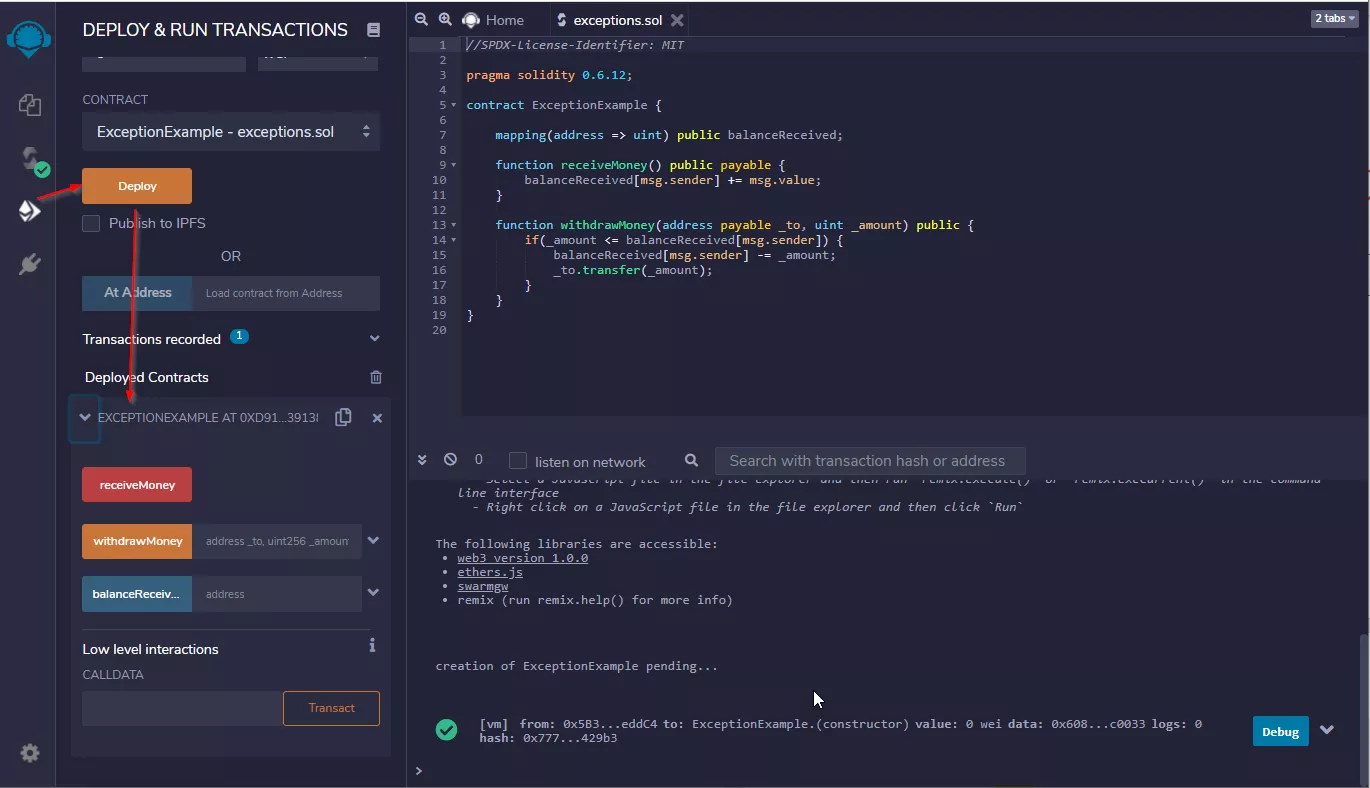Exception Handling: Require, Assert and Revert in Solidity¶
Now its time to learn about more about Exception handling. At the end I want you to be fully aware of when and how to use require, assert and revert, as well as try-catch and named exceptions.

If you come from a Java Background, you're probably going to be a bit disappointed. Exceptions in Solidity don't work quite the way you're used to use them. Let's start with an example...
The Smart Contract¶
Let's start with this basic Smart Contract. Attention, it's written in Solidity 0.6, not the latest version, because of the integer roll-over example that we will demonstrate.
//SPDX-License-Identifier: MIT
pragma solidity 0.6.12;
contract ExceptionRequireExample {
mapping(address => uint) public balanceReceived;
function receiveMoney() public payable {
balanceReceived[msg.sender] += msg.value;
}
function withdrawMoney(address payable _to, uint _amount) public {
if(_amount <= balanceReceived[msg.sender]) {
balanceReceived[msg.sender] -= _amount;
_to.transfer(_amount);
}
}
}
Add this Smart Contract to Remix. The correct Solidity Compiler Version should be selected automatically, but double check, to make sure everything is in order:
Okay, what does the Smart Contract do? It's a simplistic wallet contract.
- You can send Ether to the Smart Contract (via
receiveMoney). - You can withdraw Ether via
withdrawMoney - The Balance of your account is stored in the balanceReceived mapping.
So far so good, its pretty in line what we did before. Pay attention to the withdrawMoney function. There is an if-else control structure. If you don't have enough balance, then simply nothing happens. That is not ideal, there is no user-feedback.
Let's give it a try!
Try the Smart Contract¶
Deploy the Smart Contract. Head over to the "Deploy & Run Transactions" Plugin and Deploy it.
- Copy your address into the withdraw money field.
- Enter a number, like 1000, and
- Hit withdrawMoney
You see, the transaction works without any problem. That's not good, because internally nothing happened and the user has the feedback that he just did a withdrawal for 1000 wei. Although nothing happened.
Try yourself first
Before heading to the next step, try yourself first to replace the if/else with a require()
Require is here for user-input validation and if it evaluates to false, it will throw an exception.
For example require(false) or require(1 == 0) will throw an exception. You can optionally add an error message require(false, "Some Error Message")
Add a Require¶
Alright, now it's time to add a require instead of the if/else control structure. Did you try? Let's compare our code:
//SPDX-License-Identifier: MIT
pragma solidity 0.6.12;
contract ExceptionExample {
mapping(address => uint) public balanceReceived;
function receiveMoney() public payable {
balanceReceived[msg.sender] += msg.value;
}
function withdrawMoney(address payable _to, uint _amount) public {
require(_amount <= balanceReceived[msg.sender], "Not Enough Funds, aborting");
balanceReceived[msg.sender] -= _amount;
_to.transfer(_amount);
}
}
If you run this now and try to withdraw more Ether than you have, it will output an error. Repeat the steps from before:
- Deploy a new Instance!
- Copy your address
- Enter an amount
- Click on "withdrawMoney"
Observe the log window:
How cool is that! Not only your transaction fails, which is what we want, we also get proper feedback to the user. Great! But if we have require statements, what are assert for?
Let's check it out!



